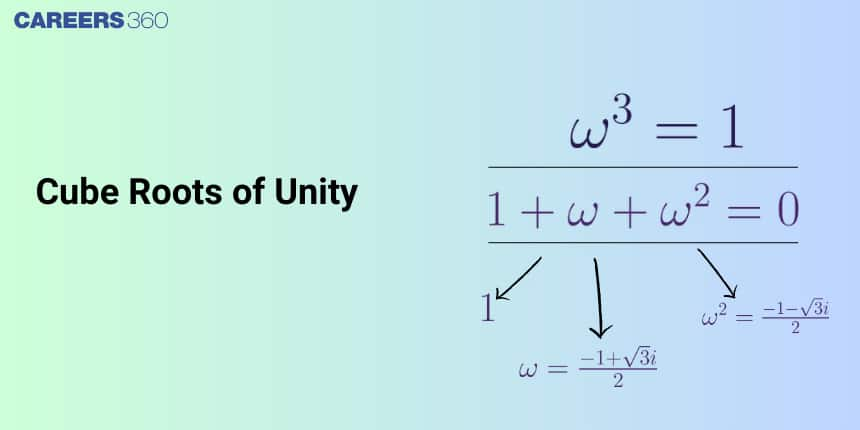Cube roots of unity
Cube roots of unity are significant in various fields of mathematics, including algebra, number theory, and complex analysis. The cube root of unity is effective because it is cyclic in nature. They provide a fundamental example of roots of unity, which are essential in understanding polynomial equations, symmetries, and cyclic groups.
JEE Main: Study Materials | High Scoring Topics | Preparation Guide
JEE Main: Syllabus | Sample Papers | Mock Tests | PYQs
- What is Cube Root of Unity?
- How To Find Cube Root Of Unity?
- Product of Cube Roots Of Unity
- Sum of Cube Roots of Unity
- Euler’s Formula
- Deriving Cube Roots of Unity by De Moivre's Theorem
- Properties of Cube roots of unity

In this article, we will cover the concept of the cube root of unity. This concept falls under the broader category of complex numbers and quadratic equations, a crucial Chapter in class 11 Mathematics. It is not only essential for board exams but also for competitive exams like the Joint Entrance Examination (JEE Main), and other entrance exams such as SRMJEE, BITSAT, WBJEE, BCECE, and more.
What is Cube Root of Unity?
The cube root of unity is represented as
-
-
Cube Root of Unity Value | Nature of Cube Root |
|---|---|
| 1 | Real |
| −½ + i √(3/ 2) | Complex |
| −½ – i √(3/ 2) | Complex |
How To Find Cube Root Of Unity?
Let
So,
Therefore,
If the second root is represented by
So,

Product of Cube Roots Of Unity
The product of the cube roots of unity is equal to 1. This can be understood from the below expression.
Sum of Cube Roots of Unity
The sum of the cube roots of unity is equal to zero. This can be observed in the below expression.
Euler’s Formula
It shows the relation between the imaginary power of an exponent and sine and cosine, and is given by:
The cube roots of unity are
Using Euler's Formula, we can conclude the following:
-
-
-
Deriving Cube Roots of Unity by De Moivre's Theorem
Let us assume that
Now,
We can write this angle as
By substituting these values in De Moivre's theorem along with substituting
Finding the Cube Roots
- When
- When
- When
Thus, the cube roots of unity by De Moivre's theorem are:
Properties of Cube roots of unity
i)
ii) To find
Now
iii)
iv) We can see that
v) Cube roots of -1 are
vi) The cube roots of unity when represented on the complex plane have their point on vertices of a triangle circumscribed by a unit circle whose one vertices lies on the+ve X-axis.

Summary
The cube root of unity is an important aspect of complex numbers. Due to its cyclic property, it helps the fast calculation of high-power complex numbers. The main applications of the cube root of unity are solving polynomial functions, Fourier transform, group theory, and number theory.
Solved Examples Based On the Cube Root of Unity
Example 1:
Solution:
As we learned in
Cube roots of unity -
wherein
1.
given is
Hence, the answer is
Example 2: If
Solution:
As we have learned
Roots of Quadratic Equation -
- wherein
is the equation
Cube roots of unity -
- wherein
1.
Hence, the answer is 1.
Example 3: Let
Solution:
Definition of Argument/Amplitude of z in Complex Numbers -
now,
Cube roots of unity -
k=0,1,2 so z gives three roots
- wherein
Quadratic Equation
Hence, the answer is
Example 4: Let
1)
2)
3)
4)
Solution:
Hence, the answer is the option (4).
Example 5: Le
1)
2)
3)
4)
Solution:
Now,
Now, the equation with roots 1 and 101 is
Hence, the answer is option (3).
Also Read
10 Feb'25 11:53 PM
10 Feb'25 11:50 PM
10 Feb'25 11:30 PM
10 Feb'25 09:26 PM
10 Feb'25 09:23 PM
10 Feb'25 09:16 PM
10 Feb'25 08:47 PM
10 Feb'25 08:39 PM
10 Feb'25 08:31 PM
10 Feb'25 08:26 PM
